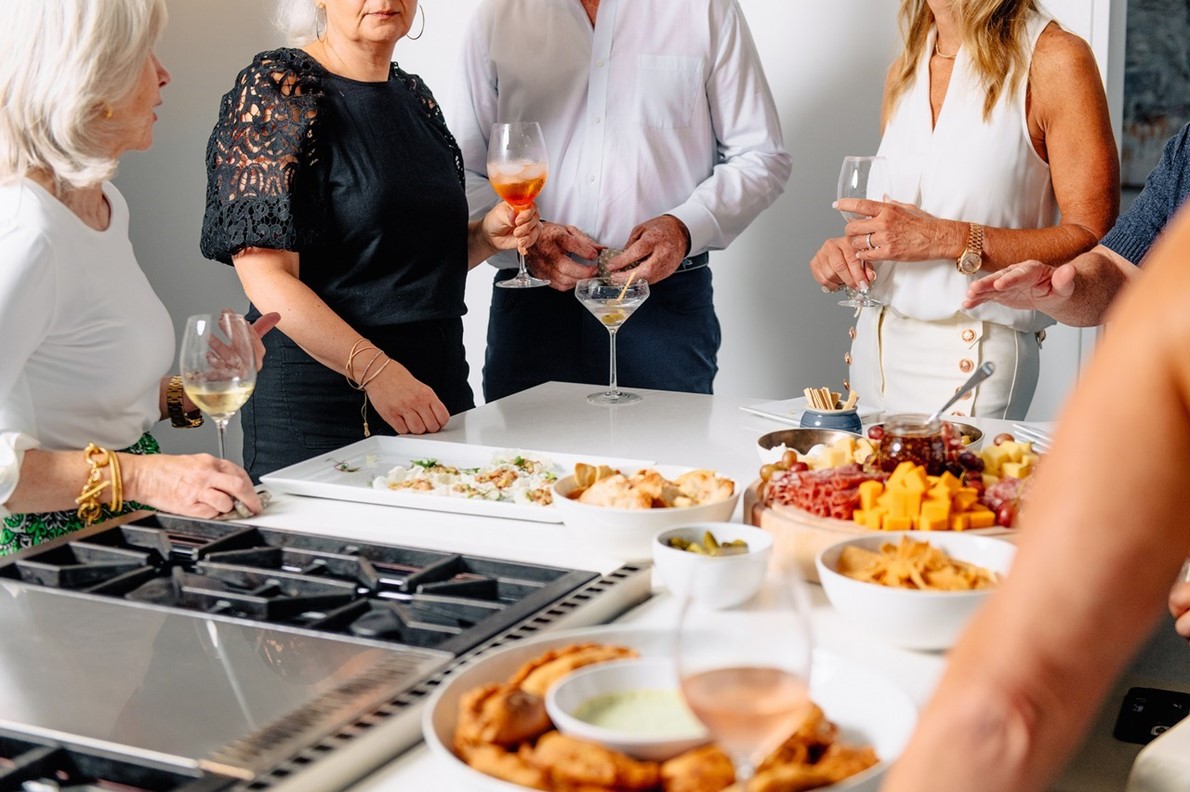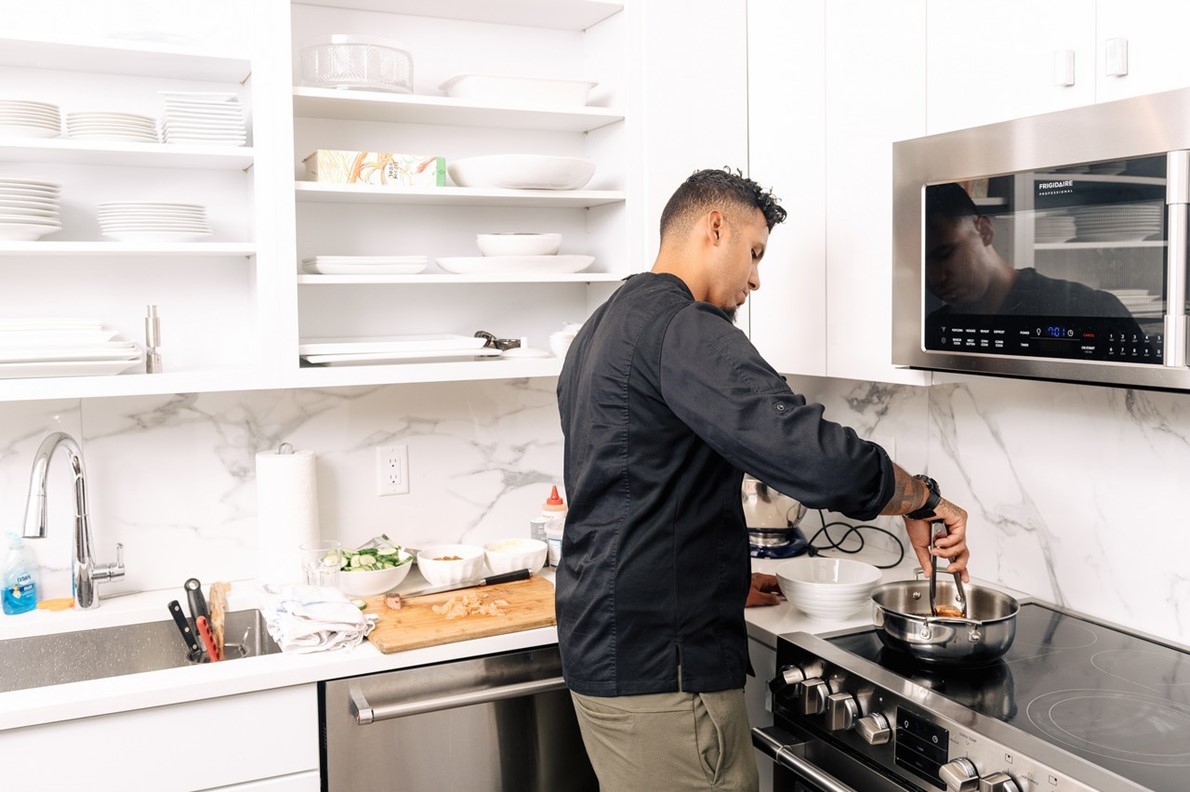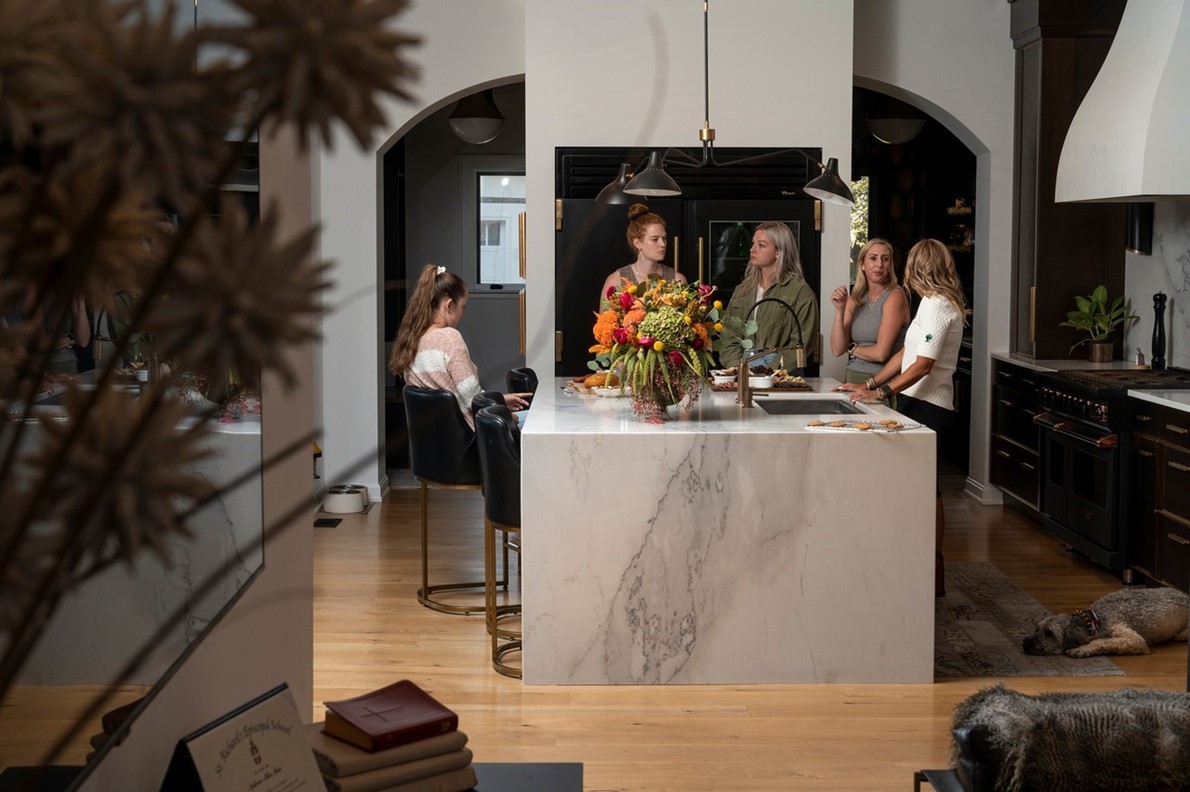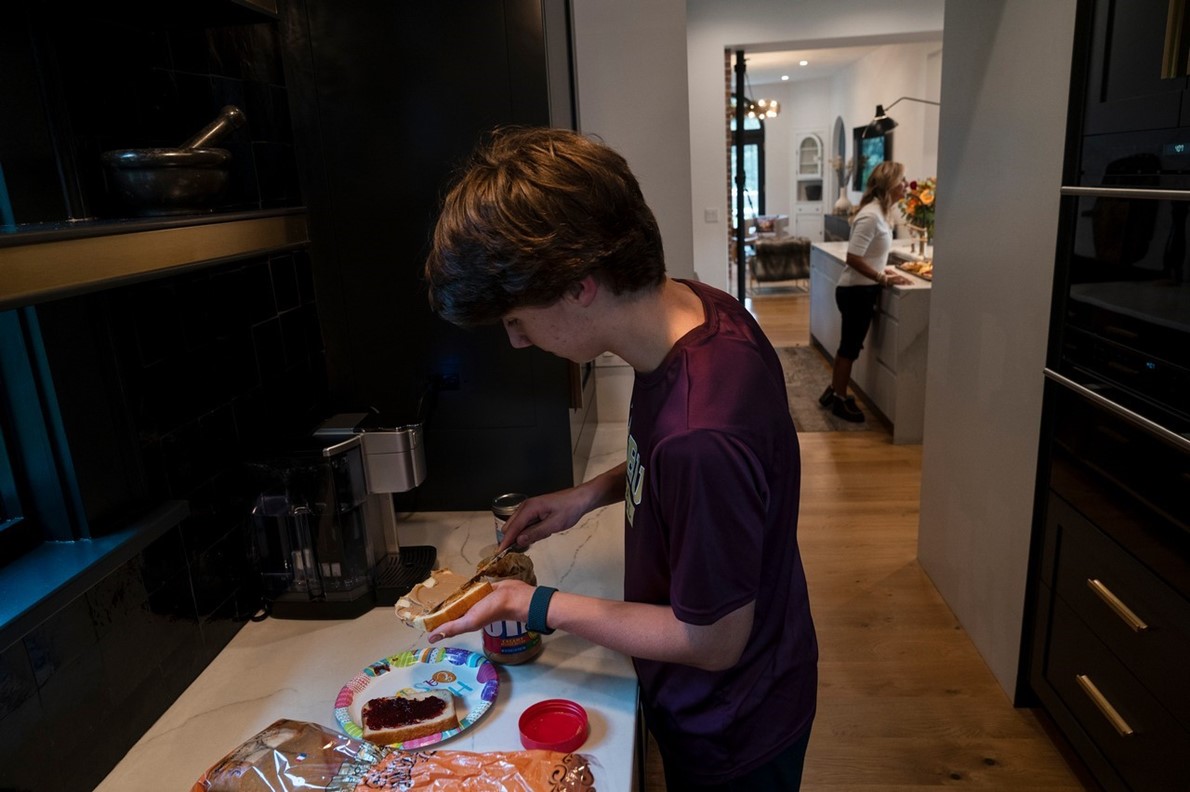The kitchen gains an offstage partner
New York Times
last updated: Sep 19,2022

In May,
about 30 eighth graders gathered around the large island in an Indianapolis
kitchen to belt out “The sun’ll come out tomorrow” to celebrate a successful
school production of “Annie.” About 60 parents cheered them on, spilling out
onto the patio.اضافة اعلان
For Jayme Moss, the host who opened her home to the guests, the moment marked another milestone: Not a single dirty plate, tray, or bowl tarnished the photos or videos. The sizable mess that comes from serving pasta and cake to a crowd of 90 was hidden in her back kitchen, a smaller room tucked behind the main one.
“Normally you take that picture or video, and there would be stuff all over the kitchen,” Moss, 49, said. Instead, “everything was in the back”.
Last year she and her husband, Bradley Moss, finished renovating their 1929 French chateau-style home. Adjacent to their main kitchen — an open-concept space with fumed oak cabinets, a Viking stove, and Calacatta countertops — they built a smaller one with a set of cabinets, a sink, an induction stove, an oven, an ice-maker, and a convection microwave.
The back kitchen, in essence a pantry on overdrive, has become increasingly popular in recent years, according to architects, designers and homebuilders. It’s particularly desirable in new construction where floor plans are as flexible as wish lists. But gut an existing home to the studs, or add an addition, like the Moss family did, and room for a second cooking space emerges.

Back kitchens come with as many names as they do appliances: the dirty kitchen, the messy kitchen, the prep kitchen, the working kitchen and the scullery kitchen, to name a few. These auxiliary spaces reinvent the humble pantry as the hardworking engine of the house. With the dirty work happening offstage, the main kitchen can shine, an immaculate centerpiece to be marveled, not sullied by spaghetti sauce and sheet pans.
“I like a place that, quite frankly, looks like it’s not lived in,” said Jayme Moss, a co-founder and board member of Versapay, a financial technology company. Bradley Moss, 49, is the president and CEO of a medical testing lab in Indianapolis.
Their back kitchen is visible from their main one, with art deco brass and gold tiles peeking through an archway. In hindsight, Jayme Moss would like to see even less of it. “If I had to do it all over again, I’d like it to be where I couldn’t see it at all,” she said.

The ultrarich have long had their “Downton Abbey”-style chef kitchens, fully equipped industrial spaces, out of sight and the domain of caterers and personal cooks. But the back kitchen is not meant to replace the main kitchen. Nor is it the spare kitchen sometimes found in the basements of modest homes, used to roast Thanksgiving turkeys, make Sunday gravy or prepare Passover meals. It is instead an extension of the main kitchen, cropping up in new homes that cost from around $1 million to $5 million to build and in kitchen renovations with five- to six-figure budgets, according to builders and designers.
Emily Clark, who with her husband owns Clark & Co., a custom homebuilder in Idaho, has witnessed the evolution of the pantry over the past decade. As the open-concept kitchen evolved into an extension of the living room — with open shelves and windows replacing upper cabinets, and kitchen islands looking increasingly like dining furniture rather than working countertops — the pantry has been given an increasingly bigger role, too, re-imagined as a well-appointed and highly stylized room for prepping, cooking, and cleaning.

“Once you start expanding and adding the dishwasher, then it’s like, ‘Well, what if I put a baking center back there?’” Clark said.
Cloistered away in a private workspace, “I can prep my cookies and put them in the oven with all of the measuring cups and mixing bowls. And then I can bring my beautiful warm cookies out of the oven into my serving kitchen,” she said.
The supersize comeback
Amanda Lantz, an interior designer in Indiana, said that every one of her new construction projects included a back kitchen, a marked change from 2019, when none had one. She sees the coronavirus pandemic as a catalyst.
“People were stocking up more. You were cooking more, you were using your kitchen more,” she said, referring to the height of the pandemic. “So then, when they’ve gone to build the next house, they’ve felt that they don’t have enough space.”
Homeowners want the pantry to look pretty, too. After all, home organizing has become a competitive sport — cue Khloe Kardashian’s backlit beige pantry, a shrine to packaged goods. The expectations are now high for a room that once housed brooms and large packages from Costco.
“People want to walk in and shop their pantry,” Clark, the homebuilder, said.
While some people may have duplicate sets of cookware for both spaces, most tend to use the pantry for dedicated tasks, doubling up on only a few items, like spatulas. Maybe the induction stovetop in the back is the children’s domain, while the Viking gas one is for the parents, as is the case in the Moss household. Or perhaps the second refrigerator stores drinks and frozen goods while the one in the front is for fresh produce.

Butler’s pantries have a long history in kitchen design, popular in late 19th-century and early 20th-century homes, when the upper class used them as staging areas for staffers and storage for fine china. But they faded from fashion in the postwar era. Now, as they make a supersize comeback, Tiffany Skilling, who designed the Moss family home and specializes in historic renovations, sees the moment as a nod to the stately homes of the past.
This generation of homeowners may be coming around to the idea that separate rooms are not such a bad idea.
“I always tell everyone, break it up into different tasks,” she said.
Building two kitchens is not cheap. Costs vary depending on the quality of the finishes and appliances, generally ranging from $25,000 to $50,000, according to designers. The Mosses spent around $300,000 on their main kitchen and about $60,000 on the back one.
In 2020, Holly and Craig VonDemfange built a $1.4 million house, designed by Clark & Co., near Boise, Idaho. Holly VonDemfange estimates that the open-concept kitchen and pantry were the most expensive parts of the project. Their main kitchen, with white cabinets and a 3.6m-wide oven hood, is in the center of their 371sq.m. house. But the pantry, hidden behind a pocket door, is where a lot of the action happens.
“The kids pull out the air fryer and put a couple of tacos in there,” said Holly VonDemfange, 47, a business lead at Meta. “It is as used, if not more,” as the big kitchen, she said. Craig VonDemfange, 53, is the founder and CEO of a virtual accounting and bookkeeping service.
Drawback or ‘fabulous’?
Stuff enough gadgets and appliances into a second kitchen, and at some point it cannibalizes the main one. Cathy Purple Cherry, the principal of Purple Cherry Architects, with offices in Maryland, Virginia, and West Virginia, has seen this happen in the new homes she designs. If the induction stove is in the back and it’s easier to use than the gas one out front, at some point, you may start doing all the cooking back there. Cherry witnessed this when she had dinner at a client’s new house in Annapolis, Maryland. The host spent much of the evening out of sight in the back kitchen, cooking steaks, while Cherry waited for her to emerge.
“When you bring that stove element to the back, you have to watch out, because it can actually draw you away from the socialization that happens around the kitchen,” she said. To avoid that risk, Cherry discourages her clients from adding a cooktop to the back kitchen. But homeowners do not always listen.

When Kelly Ladwig and Suzie Stolarz were designing their nearly 400sq.m. house in Nashville, Tennessee, their architect was initially skeptical of the concept of a back kitchen.
“He didn’t quite understand what we wanted to do,” Ladwig said. “His reaction was: ‘Well, it’s your house. Are you sure you don’t want to use this for something else?’ But then as we started designing it, he was like, ‘This is fabulous.’”
“It’s a kitchen for the kitchen,” said Ladwig, who estimates that together, the two kitchens accounted for about $400,000 of their $1.45 million building costs.
‘A kitchenette on steroids’
The popularity of back kitchens is difficult to track, with terms like “butler’s pantry” and “second kitchen” turning up in only about 1 percent of listings on Zillow. Most municipalities have rules prohibiting two kitchens in separate parts of the same single-family home because of the risk that homeowners might illegally rent out part of the house as an apartment. But a back kitchen can skirt such restrictions if it is defined as part of a single, large kitchen.
“The second kitchen is always referred to as a kitchenette,” said Douglas C. Wright, a New York City architect. “It’s a kitchenette on steroids.”
Michelle and Greg Barry have become so accustomed to the back kitchen in their Rumson, New Jersey, home that they’re having a hard time accepting that they might have to forgo one in Miami, where they moved last spring.
“We’re stuck looking for a house with two kitchens in Miami because we’re so spoiled here,” said Michelle Barry, 53, who is currently renting a house in Miami with a tight galley kitchen. So far, they have not had any luck finding their dream double kitchen in a Florida market that Barry described as “insane”.
Read more Property
Jordan News
For Jayme Moss, the host who opened her home to the guests, the moment marked another milestone: Not a single dirty plate, tray, or bowl tarnished the photos or videos. The sizable mess that comes from serving pasta and cake to a crowd of 90 was hidden in her back kitchen, a smaller room tucked behind the main one.
“Normally you take that picture or video, and there would be stuff all over the kitchen,” Moss, 49, said. Instead, “everything was in the back”.
Last year she and her husband, Bradley Moss, finished renovating their 1929 French chateau-style home. Adjacent to their main kitchen — an open-concept space with fumed oak cabinets, a Viking stove, and Calacatta countertops — they built a smaller one with a set of cabinets, a sink, an induction stove, an oven, an ice-maker, and a convection microwave.
The back kitchen, in essence a pantry on overdrive, has become increasingly popular in recent years, according to architects, designers and homebuilders. It’s particularly desirable in new construction where floor plans are as flexible as wish lists. But gut an existing home to the studs, or add an addition, like the Moss family did, and room for a second cooking space emerges.

Back kitchens come with as many names as they do appliances: the dirty kitchen, the messy kitchen, the prep kitchen, the working kitchen and the scullery kitchen, to name a few. These auxiliary spaces reinvent the humble pantry as the hardworking engine of the house. With the dirty work happening offstage, the main kitchen can shine, an immaculate centerpiece to be marveled, not sullied by spaghetti sauce and sheet pans.
“I like a place that, quite frankly, looks like it’s not lived in,” said Jayme Moss, a co-founder and board member of Versapay, a financial technology company. Bradley Moss, 49, is the president and CEO of a medical testing lab in Indianapolis.
Their back kitchen is visible from their main one, with art deco brass and gold tiles peeking through an archway. In hindsight, Jayme Moss would like to see even less of it. “If I had to do it all over again, I’d like it to be where I couldn’t see it at all,” she said.

The ultrarich have long had their “Downton Abbey”-style chef kitchens, fully equipped industrial spaces, out of sight and the domain of caterers and personal cooks. But the back kitchen is not meant to replace the main kitchen. Nor is it the spare kitchen sometimes found in the basements of modest homes, used to roast Thanksgiving turkeys, make Sunday gravy or prepare Passover meals. It is instead an extension of the main kitchen, cropping up in new homes that cost from around $1 million to $5 million to build and in kitchen renovations with five- to six-figure budgets, according to builders and designers.
Emily Clark, who with her husband owns Clark & Co., a custom homebuilder in Idaho, has witnessed the evolution of the pantry over the past decade. As the open-concept kitchen evolved into an extension of the living room — with open shelves and windows replacing upper cabinets, and kitchen islands looking increasingly like dining furniture rather than working countertops — the pantry has been given an increasingly bigger role, too, re-imagined as a well-appointed and highly stylized room for prepping, cooking, and cleaning.

“Once you start expanding and adding the dishwasher, then it’s like, ‘Well, what if I put a baking center back there?’” Clark said.
Cloistered away in a private workspace, “I can prep my cookies and put them in the oven with all of the measuring cups and mixing bowls. And then I can bring my beautiful warm cookies out of the oven into my serving kitchen,” she said.
The supersize comeback
Amanda Lantz, an interior designer in Indiana, said that every one of her new construction projects included a back kitchen, a marked change from 2019, when none had one. She sees the coronavirus pandemic as a catalyst.
“People were stocking up more. You were cooking more, you were using your kitchen more,” she said, referring to the height of the pandemic. “So then, when they’ve gone to build the next house, they’ve felt that they don’t have enough space.”
Homeowners want the pantry to look pretty, too. After all, home organizing has become a competitive sport — cue Khloe Kardashian’s backlit beige pantry, a shrine to packaged goods. The expectations are now high for a room that once housed brooms and large packages from Costco.
“People want to walk in and shop their pantry,” Clark, the homebuilder, said.
While some people may have duplicate sets of cookware for both spaces, most tend to use the pantry for dedicated tasks, doubling up on only a few items, like spatulas. Maybe the induction stovetop in the back is the children’s domain, while the Viking gas one is for the parents, as is the case in the Moss household. Or perhaps the second refrigerator stores drinks and frozen goods while the one in the front is for fresh produce.

Butler’s pantries have a long history in kitchen design, popular in late 19th-century and early 20th-century homes, when the upper class used them as staging areas for staffers and storage for fine china. But they faded from fashion in the postwar era. Now, as they make a supersize comeback, Tiffany Skilling, who designed the Moss family home and specializes in historic renovations, sees the moment as a nod to the stately homes of the past.
This generation of homeowners may be coming around to the idea that separate rooms are not such a bad idea.
“I always tell everyone, break it up into different tasks,” she said.
Building two kitchens is not cheap. Costs vary depending on the quality of the finishes and appliances, generally ranging from $25,000 to $50,000, according to designers. The Mosses spent around $300,000 on their main kitchen and about $60,000 on the back one.
In 2020, Holly and Craig VonDemfange built a $1.4 million house, designed by Clark & Co., near Boise, Idaho. Holly VonDemfange estimates that the open-concept kitchen and pantry were the most expensive parts of the project. Their main kitchen, with white cabinets and a 3.6m-wide oven hood, is in the center of their 371sq.m. house. But the pantry, hidden behind a pocket door, is where a lot of the action happens.
“The kids pull out the air fryer and put a couple of tacos in there,” said Holly VonDemfange, 47, a business lead at Meta. “It is as used, if not more,” as the big kitchen, she said. Craig VonDemfange, 53, is the founder and CEO of a virtual accounting and bookkeeping service.
Drawback or ‘fabulous’?
Stuff enough gadgets and appliances into a second kitchen, and at some point it cannibalizes the main one. Cathy Purple Cherry, the principal of Purple Cherry Architects, with offices in Maryland, Virginia, and West Virginia, has seen this happen in the new homes she designs. If the induction stove is in the back and it’s easier to use than the gas one out front, at some point, you may start doing all the cooking back there. Cherry witnessed this when she had dinner at a client’s new house in Annapolis, Maryland. The host spent much of the evening out of sight in the back kitchen, cooking steaks, while Cherry waited for her to emerge.
“When you bring that stove element to the back, you have to watch out, because it can actually draw you away from the socialization that happens around the kitchen,” she said. To avoid that risk, Cherry discourages her clients from adding a cooktop to the back kitchen. But homeowners do not always listen.

When Kelly Ladwig and Suzie Stolarz were designing their nearly 400sq.m. house in Nashville, Tennessee, their architect was initially skeptical of the concept of a back kitchen.
“He didn’t quite understand what we wanted to do,” Ladwig said. “His reaction was: ‘Well, it’s your house. Are you sure you don’t want to use this for something else?’ But then as we started designing it, he was like, ‘This is fabulous.’”
“It’s a kitchen for the kitchen,” said Ladwig, who estimates that together, the two kitchens accounted for about $400,000 of their $1.45 million building costs.
‘A kitchenette on steroids’
The popularity of back kitchens is difficult to track, with terms like “butler’s pantry” and “second kitchen” turning up in only about 1 percent of listings on Zillow. Most municipalities have rules prohibiting two kitchens in separate parts of the same single-family home because of the risk that homeowners might illegally rent out part of the house as an apartment. But a back kitchen can skirt such restrictions if it is defined as part of a single, large kitchen.
“The second kitchen is always referred to as a kitchenette,” said Douglas C. Wright, a New York City architect. “It’s a kitchenette on steroids.”
Michelle and Greg Barry have become so accustomed to the back kitchen in their Rumson, New Jersey, home that they’re having a hard time accepting that they might have to forgo one in Miami, where they moved last spring.
“We’re stuck looking for a house with two kitchens in Miami because we’re so spoiled here,” said Michelle Barry, 53, who is currently renting a house in Miami with a tight galley kitchen. So far, they have not had any luck finding their dream double kitchen in a Florida market that Barry described as “insane”.
Read more Property
Jordan News

